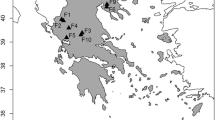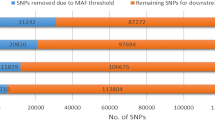Abstract
The Jeju horse is an indigenous Korean horse breed that is currently registered with the Food and Agriculture Organization of the United Nations. However, there is severe lack of genomic studies on Jeju horse. This study was conducted to investigate genetic characteristics of horses including Jeju horse, Thoroughbred and Jeju crossbred (Jeju × Thoroughbred) populations. We compared the genomes of three horse populations using the Equine SNP70 Beadchip array. Short-range Linkage disequilibrium was the highest in Thoroughbred, whereas r2 values were lowest in Jeju horse. Expected heterozygosity was the highest in Jeju crossbred (0.351), followed by the Thoroughbred (0.337) and Jeju horse (0.311). The level of inbreeding was slightly higher in Thoroughbred (− 0.009) than in Jeju crossbred (− 0.035) and Jeju horse (− 0.038). FST value was the highest between Jeju horse and Thoroughbred (0.113), whereas Jeju crossbred and Thoroughbred showed the lowest value (0.031). The genetic relationship was further assessed by principal component analysis, suggesting that Jeju crossbred is more genetically similar to Thoroughbred than Jeju horse population. Additionally, we detected potential selection signatures, for example, in loci located on LCORL/NCAPG and PROP1 genes that are known to influence body. Genome-wide analyses of the three horse populations showed that all the breeds had somewhat a low level of inbreeding within each population. In the population structure analysis, we found that Jeju crossbred was genetically closer to Thoroughbred than Jeju horse. Furthermore, we identified several signatures of selection which might be associated with traits of interest. To our current knowledge, this study is the first genomic research, analyzing genetic relationships of Jeju horse, Thoroughbred and Jeju crossbred.




Similar content being viewed by others

References
Ardlie KG, Kruglyak L, Seielstad M (2002) Patterns of linkage disequilibrium in the human genome. Nat Rev Genet 3:299–309
Binns MM, Boehler DA, Bailey E, Lear TL, Cardwell JM, Lambert DH (2011) Inbreeding in the Thoroughbred horse. Anim Genet 43:340–342
Bower MA, McGivney BA, Campana MG, Gu J, Andersson LS, Barrett E, Davis CR, Mikko S, Stock F, Voronkova V et al (2012) The genetic origin and history of speed in the Thoroughbred racehorse. Nat Commun 3:643
Choi SK, Cho CY, Yeon SH, Cho BW, Cho GJ (2008) Genetic characterization and polymorphisms for parentage testing of the Jeju horse using 20 microsatellite loci. J Vet Med Sci 70:1111–1115
Corbin LJ, Blott SC, Swinburne JE, Vaudin M, Bishop SC, Woolliams JA (2010) Linkage disequilibrium and historical effective population size in the Thoroughbred horse. Anim Genet 41:8–15
Davis SW, Castinetti F, Carvalho LR, Ellsworth BS, Potok MA, Lyons RH, Brinkmeier ML, Raetzman LT, Carninci P, Mortensen AH et al (2010) Molecular mechanisms of pituitary organogenesis: in search of novel regulatory genes. Mol Cell Endocrinol 323:4–19
Deladoëy J, Flück C, Büyükgebiz A, Kuhlmann BV, Eblé A, Hindmarsh PC, Wu W, Mullis PE (1999) “Hot spot” in the PROP1 gene responsible for combined pituitary hormone deficiency. J Clin Endocrinol Metab 84:1645–1650
Do KT, Lee JH, Lee HK, Kim J, Park KD (2014) Estimation of effective population size using single-nucleotide polymorphism (SNP) data in Jeju horse. J Anim Sci Technol 56(1):28
Excoffier L, Slatkin M (1995) Maximum-likelihood estimation of molecular haplotype frequencies in a diploid population. Mol Biol Evol 12(5):921–927
Fu W, Dekkers JC, Lee WR, Abasht B (2015) Linkage disequilibrium in crossbred and pure line chickens. Genet Sel Evol 47(1):11
Gudbjartsson DF, Walters GB, Thorleifsson G, Stefansson H, Halldorsson BV, Zusmanovich P, Sulem P, Thorlacius S, Gylfason A, Steinberg S et al (2008) Many sequence variants affecting diversity of adult human height. Nat Genet 40:609–615
Harmon LJ, Braude S (2010) Conservation of small populations: effective population sizes, inbreeding, and the 50/500 rule. In: Braude S, Low BS (eds) An introduction to methods and models in ecology, evolution, and conservation biology. Princeton University Press, Princeton, pp 125–138
Hill WG, Robertson A (1968) Linkage disequilibrium in finite populations. Theor Appl Genet 38:226–231
Hill EW, McGivney BA, Gu J, Whiston R, Machugh DE (2010) A genome-wide SNP-association study confirms a sequence variant (g.66493737C> T) in the equine myostatin (MSTN) gene as the most powerful predictor of optimum racing distance for Thoroughbred racehorses. BMC Genom 11(1):552
Jung YH, Han SH, Shin T, Oh MY (2002) Genetic characterization of horse bone excavated from the Kwakji archaeological site, Jeju, Korea. Mol Cells 14:224–230
Kim NY (2015) Distribution of Coat Colors and Molecular Genetic Study of White Patch in Jeju Horses. Dissertation, Jeju National University
Kim NY, Shin KY, Lee CE, Han SH, Lee SS, Park YS, Ko MS, Hong HJ, Yang JH, Jang DJ et al (2012) Genetic characterization of Wolla Coat Color in Jeju Horses. J Anim Sci Technol 54:375–379
Kim J, Lee MJ, Oh WY, Kim DH, Kim SD, Choi JG, Cho BW (2015) Estimation of effective population size of Jeju Horse in Korea. J Agric Life Sci 49:67–73
Lee JE, Shin JH, Yun YM, Lee KK, Lee H, Kweon OK, Yun YS, Suh JG, Shin NS, Seong JK (2010) Genetic polymorphism of Jeju Horses by microsatellite DNA markers in Korea. Lab Anim Res 26:219–221
Lee SH, Park BH, Sharma A, Dang CG, Lee SS, Choi TJ, Choy YH, Kim HC, Jeon KJ, Kim SD (2014a) Hanwoo cattle: origin, domestication, breeding strategies and genomic selection. J Anim Sci Technol 56(1):2
Lee YS, Lee JW, Kim H (2014b) Estimating effective population size of thoroughbred horses using linkage disequilibrium and theta (4Nµ) value. Livest Sci 168:32–37
Lu D, Sargolzaei M, Kelly M, Li C, Vander Voort G, Wang Z, Plastow G, Moore S, Miller SP (2012) Linkage disequilibrium in Angus, Charolais, and Crossbred beef cattle. Front Genet 3:152
Makvandi-Nejad S, Hoffman GE, Allen JJ, Chu E, Gu E, Chandler AM, Loredo AI, Bellone RR, Mezey JG, Brooks SA et al (2012) Four loci explain 83% of size variation in the horse. PLoS ONE 7:e39929
McCue ME, Bannasch DL, Petersen JL, Gurr J, Bailey E, Binns MM, Distl O, Guerin G, Hasegawa T, Hill EW et al (2012) A high density SNP array for the domestic horse and extant Perissodactyla: utility for association mapping, genetic diversity, and phylogeny studies. PLoS Genet 8:e1002451
Meadows JR, Chan EK, Kijas JW (2008) Linkage disequilibrium compared between five populations of domestic sheep. BMC Genet 9(1):61
Metzger J, Schrimpf R, Philipp U, Distl O (2013) Expression levels of LCORL are associated with body size in horses. PLoS ONE 8:e56497
Ministry of Agriculture, Food and Rural Affairs (2018) 2017 Actual condition survey of horse industry. http://www.mafra.go.kr/bbs/mafra/68/316966/artclView. Accessed 7 Mar 2018
Oh WY, Kim BW, Cho HW, Shin TS, Cho SK, Cho BW (2014) Analysis of associated race performance and functional characterization of conformation in Jeju Horse. J Agric Life Sci 48:99–106
Pan C, Wu C, Jia W, Xu Y, Lei C, Hu S, Lan X, Chen H (2013) A critical functional missense mutation (H173R) in the bovine PROP1 gene significantly affects growth traits in cattle. Gene 531(2):398–402
Pereira GL, Chud TC, Bernardes PA, Venturini GC, Chardulo LA, Curi RA (2017) Genotype imputation and accuracy evaluation in racing quarter horses genotyped using different commercial SNP panels. J Equine Vet Sci 58:89–96
Petersen JL, Mickelson JR, Rendahl AK, Valberg SJ, Andersson LS, Axelsson J, Bailey E, Bannasch D, Binns MM, Borges AS (2013) Genome-wide analysis reveals selection for important traits in domestic horse breeds. PLoS Genet 9:e1003211
Pritchard JK, Przeworski M (2001) Linkage disequilibrium in humans: models and data. Am J Hum Genet 69:1–14
Pryce JE, Hayes BJ, Bolormaa S, Goddard ME (2011) Polymorphic regions affecting human height also control stature in cattle. Genetics 187(3):981–984
Seo JH, Park KD, Lee HK, Kong (2016) Genetic diversity of Halla horses using microsatellite markers. J Anim Sci Technol 58(1):40
Shin TG, Yang KC, Kim SH (1993) An osteological finding of equine bones excavated from Kwakji Archaeological Site in Cheju-do. Cheju Univ J 37:85–90
Signer-Hasler H, Flury C, Haase B, Burger D, Simianer H, Leeb T, Rieder S (2012) A genome-wide association study reveals loci influencing height and other conformation traits in horses. PLoS ONE 7:e37282
Sornson MW, Wu W, Dasen JS, Flynn SE, Norman DJ, O’Connell SM, Gukovsky I, Carrière C, Ryan AK, Miller AP et al (1996) Pituitary lineage determination by the Prophet of Pit-1 homeodomain factor defective in Ames dwarfism. Nature 384:327–333
Wade CM, Giulotto E, Sigurdsson S, Zoli M, Gnerre S, Imsland F, Lear TL, Adelson DL, Bailey E, Bellone RR et al (2009) Genome sequence, comparative analysis, and population genetics of the domestic horse. Science 326:865–867
Weir BS, Cockerham CC (1984) Estimating F-statistics for the analysis of population structure. Evolution 38:1358–1370
Wright S (1951) The genetical structure of populations. Ann Eugen 15:323–354
Acknowledgements
This work was carried out with the support of “Cooperative Research Program for Agriculture Science & Technology Development (Project title: Study on the development of basic population for the use of Jeju horses, Project No. PJ01010503)” Rural Development Administration, Republic of Korea.
Author information
Authors and Affiliations
Corresponding author
Ethics declarations
Conflict of interest
The authors declare that they have no conflict of interest.
Ethical approval
All experiments and all its procedures were carried out in accordance with the regulation approved by National Institute of Animal Science (NIAS, National Institute of Animal Science’s Institutional Animal Care and Use Committee: 2014-067).
Electronic supplementary material
Below is the link to the electronic supplementary material.
Rights and permissions
About this article
Cite this article
Kim, N.Y., Seong, HS., Kim, D.C. et al. Genome-wide analyses of the Jeju, Thoroughbred, and Jeju crossbred horse populations using the high density SNP array. Genes Genom 40, 1249–1258 (2018). https://doi.org/10.1007/s13258-018-0722-0
Received:
Accepted:
Published:
Issue Date:
DOI: https://doi.org/10.1007/s13258-018-0722-0



